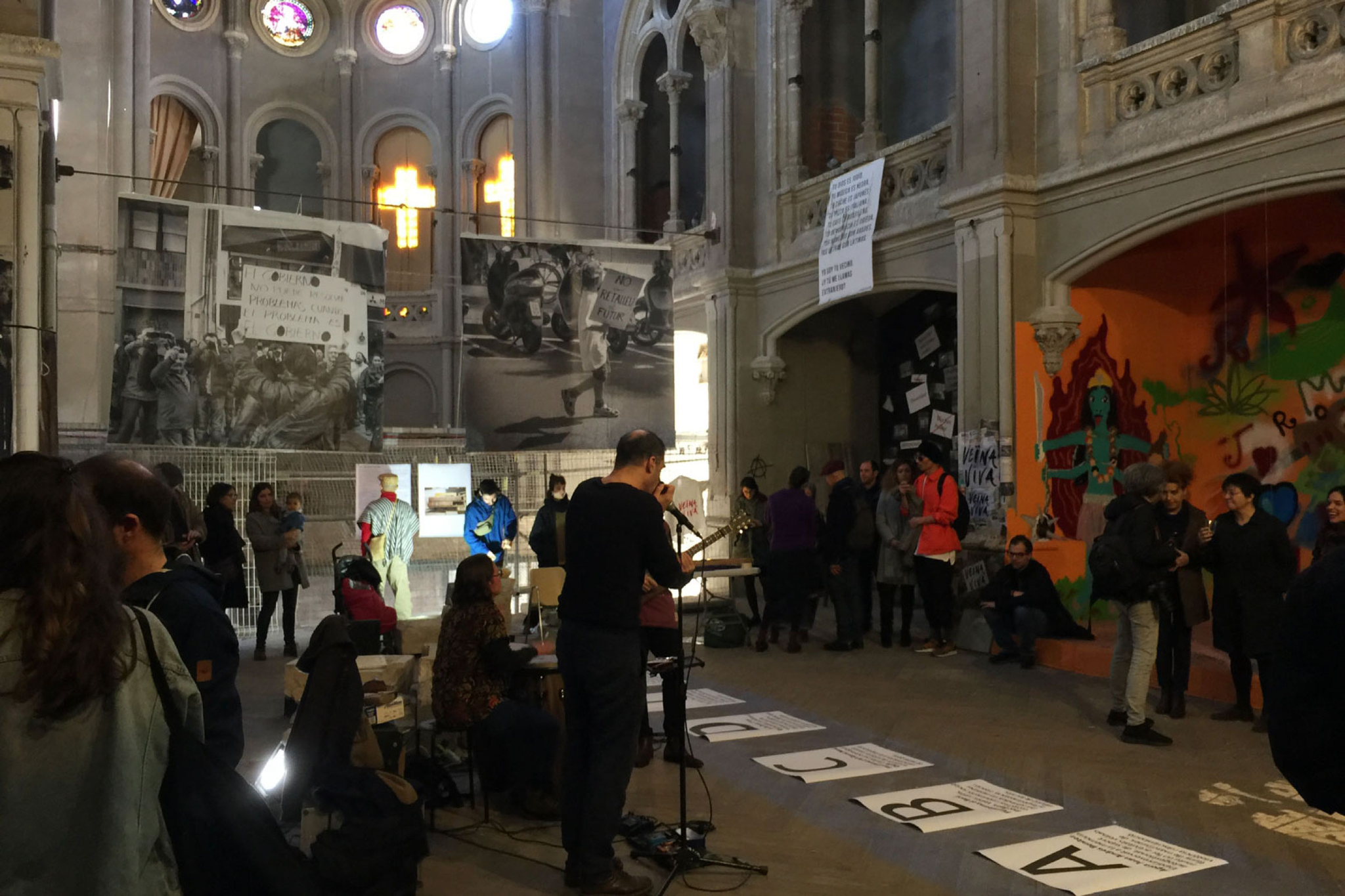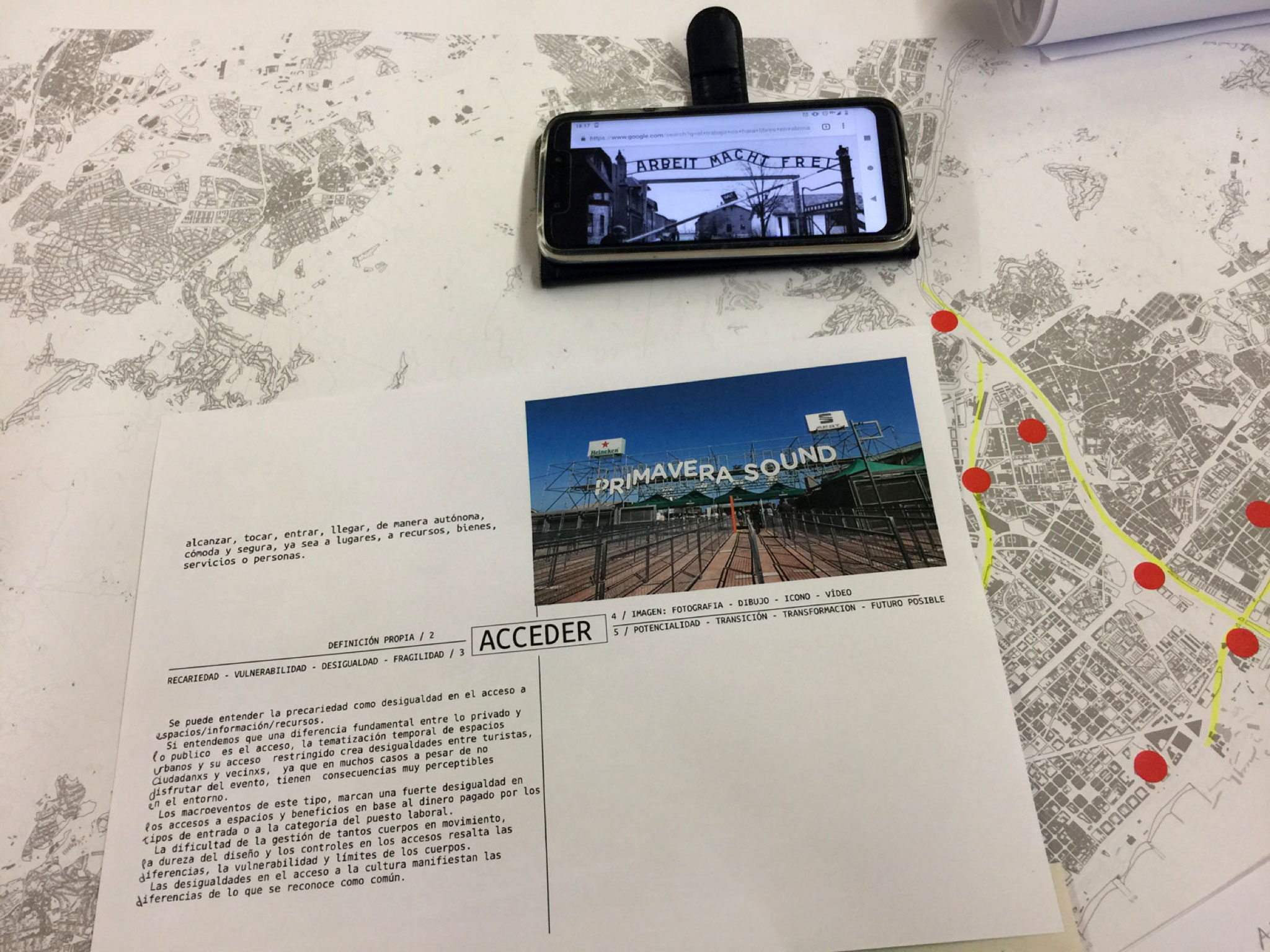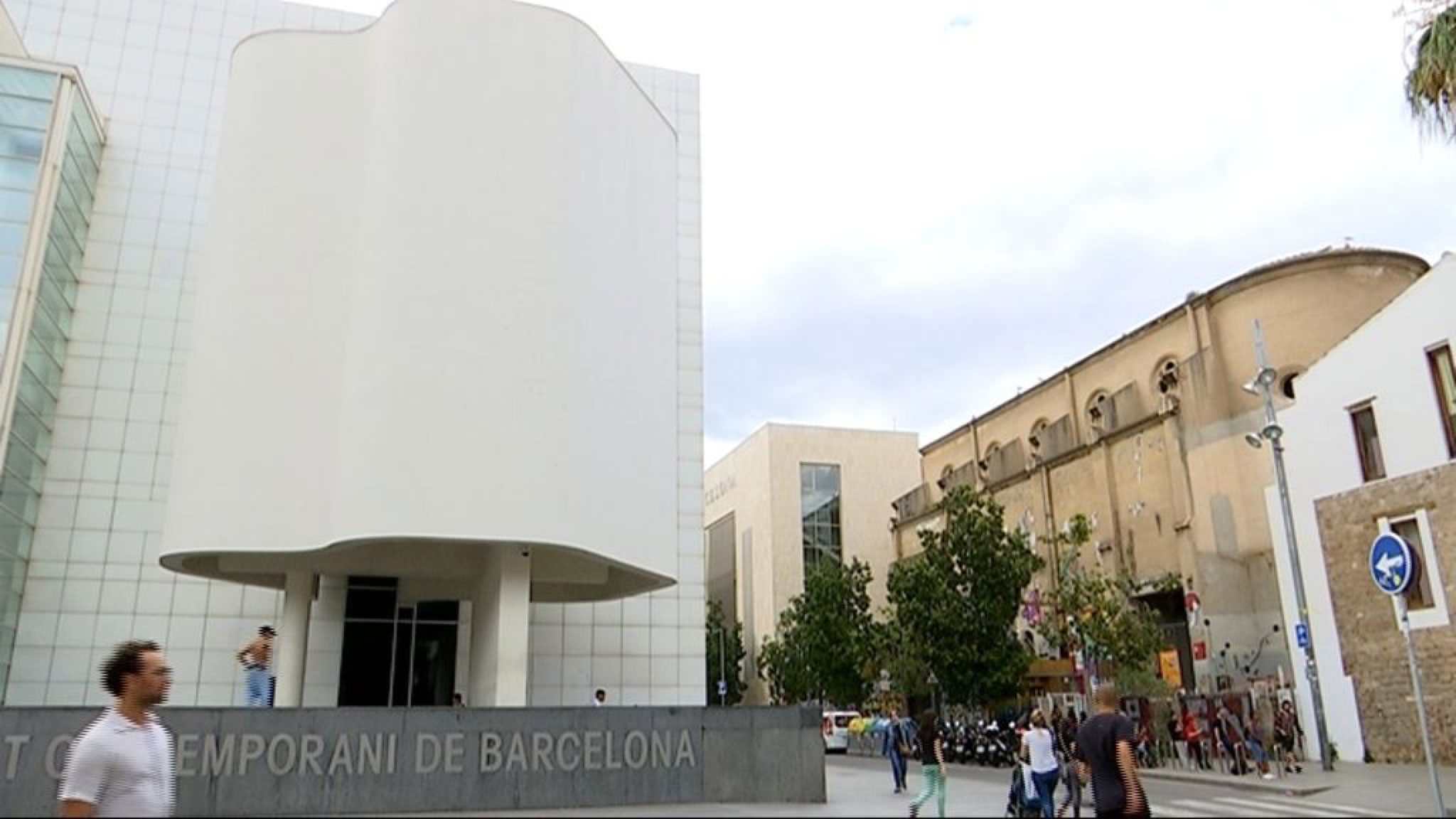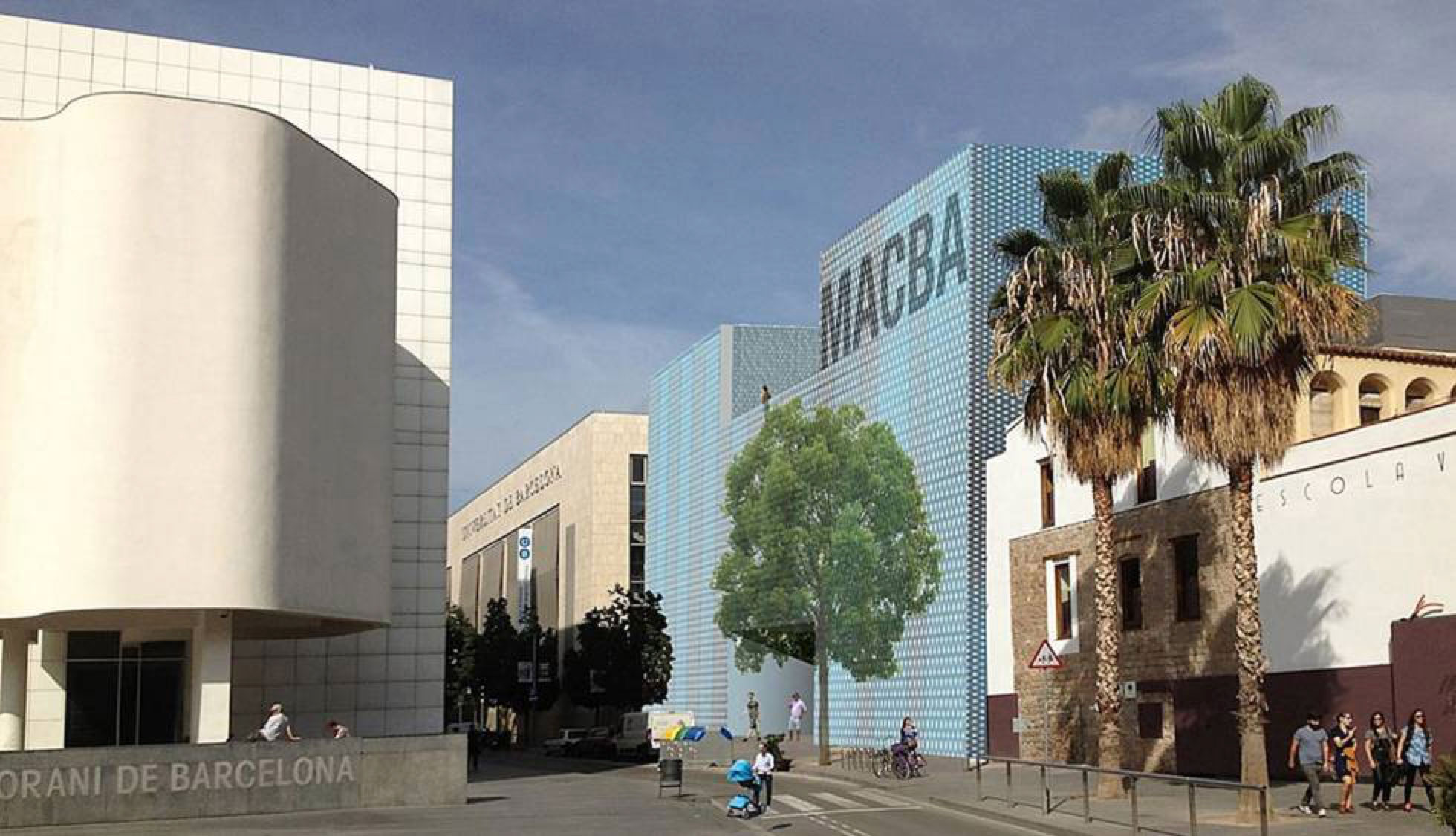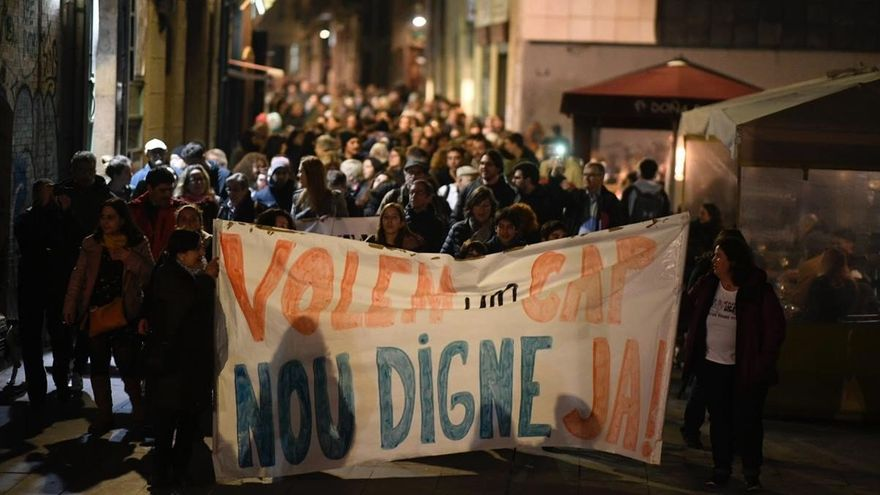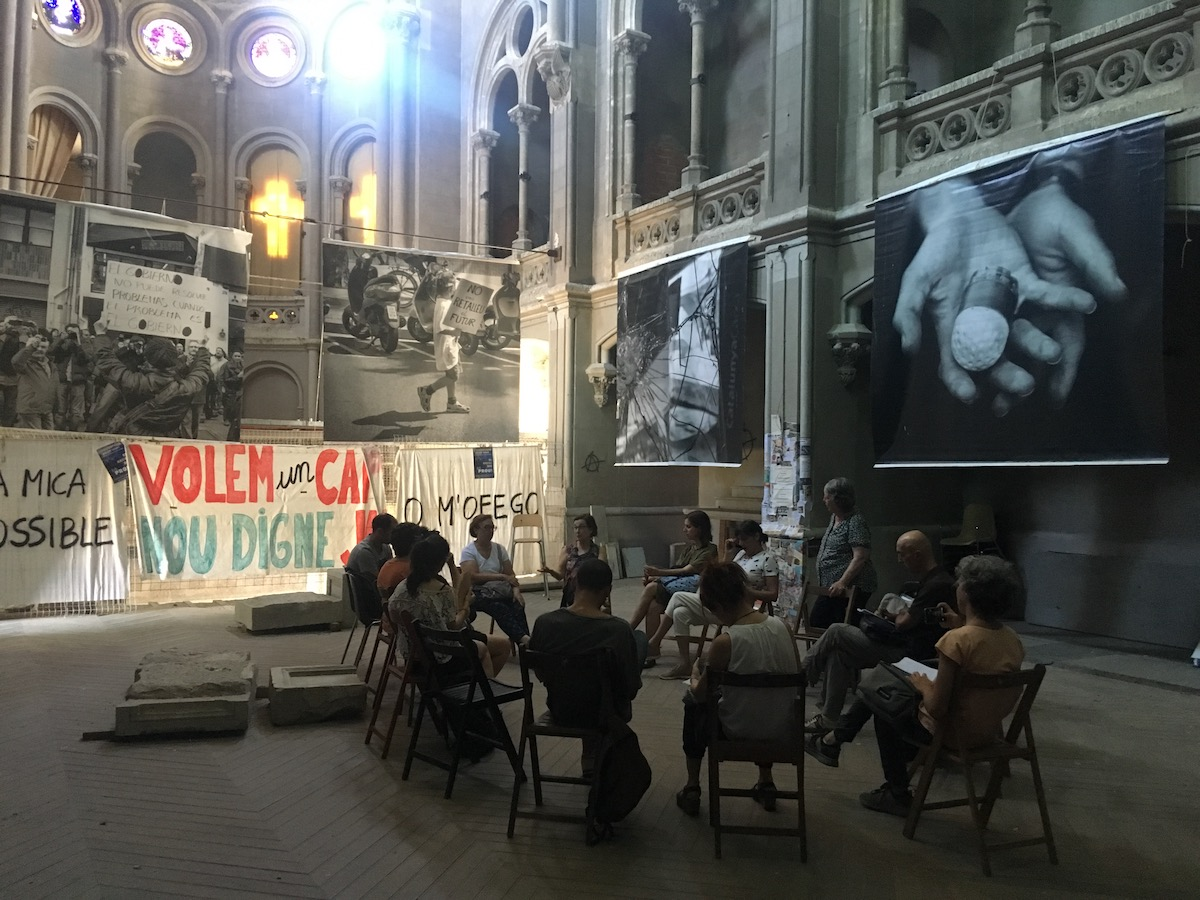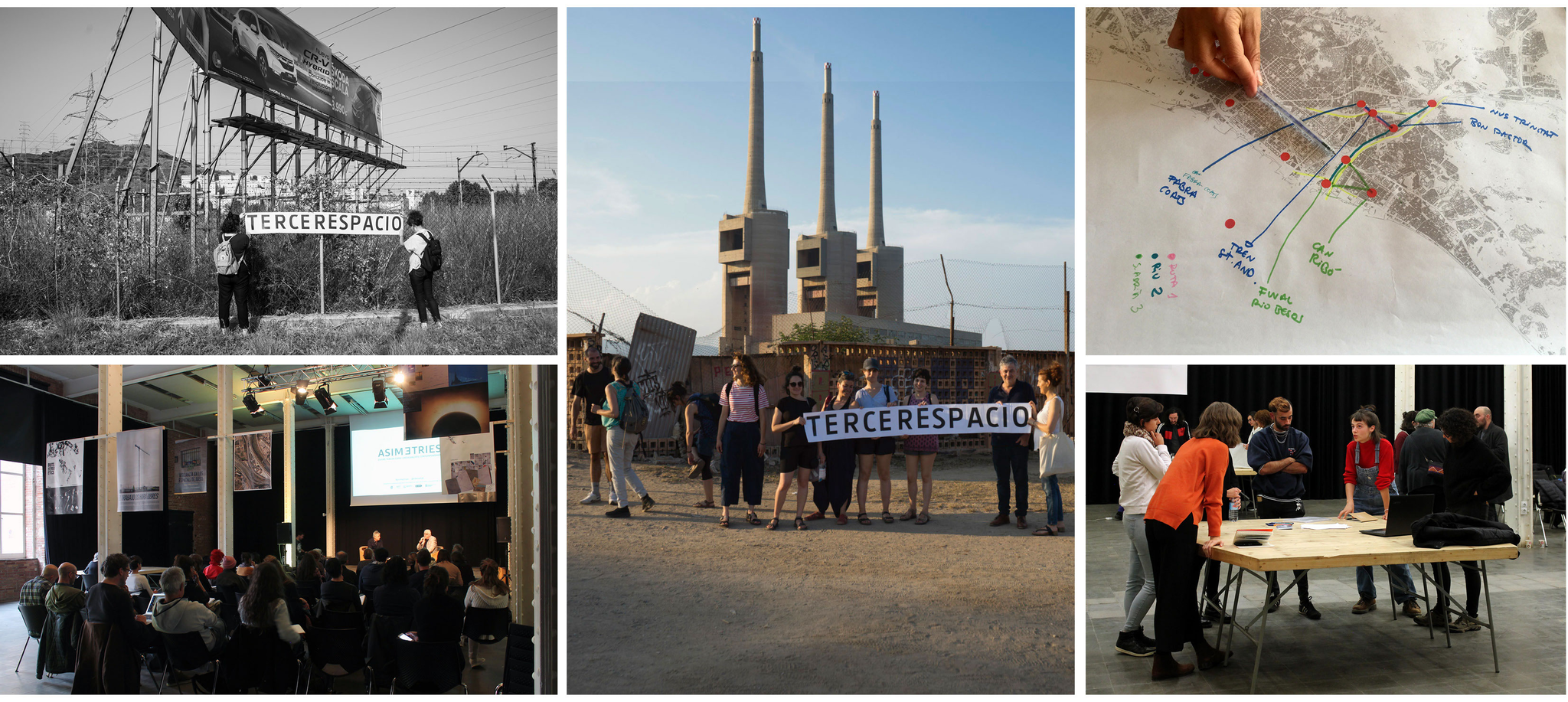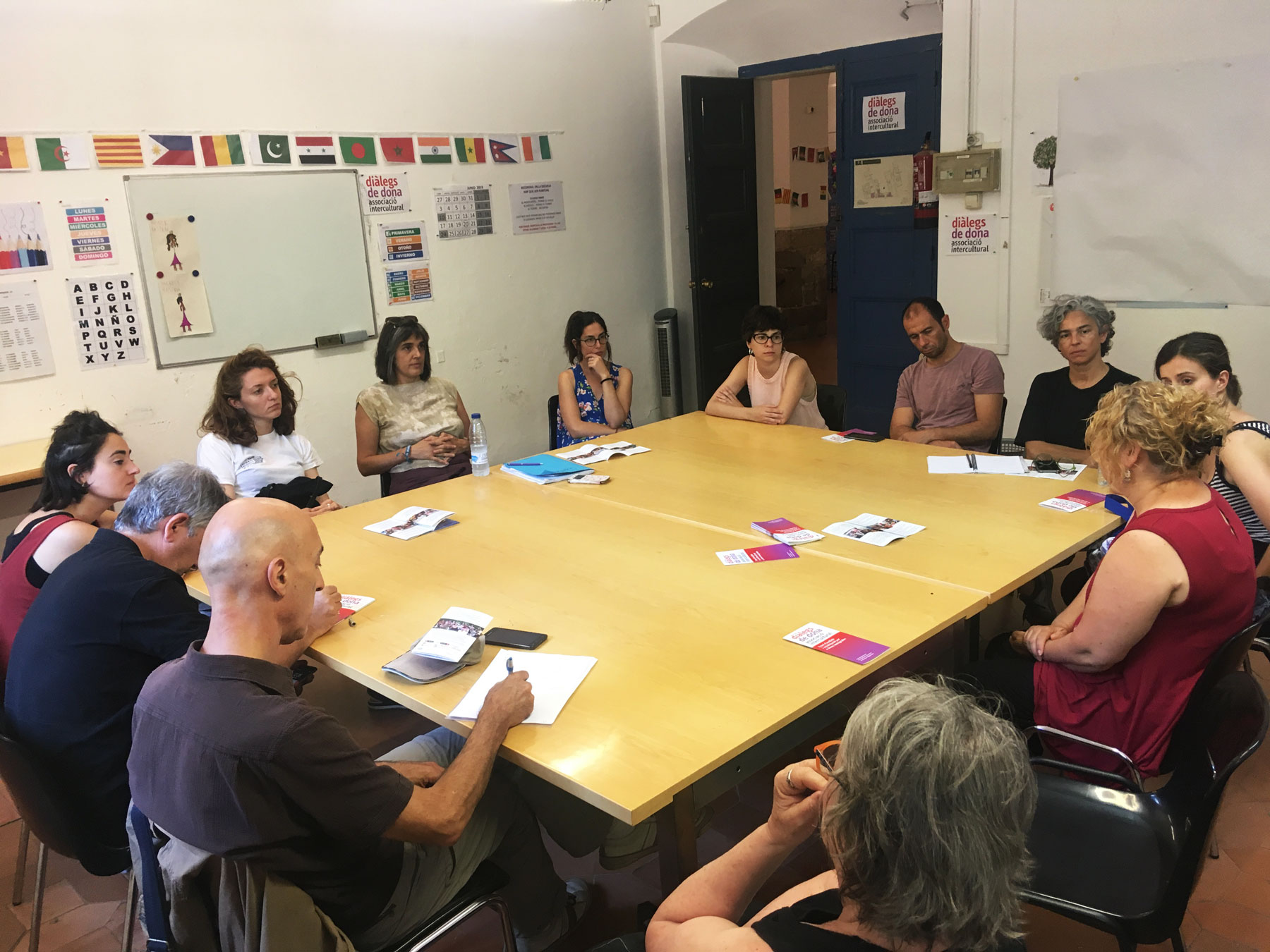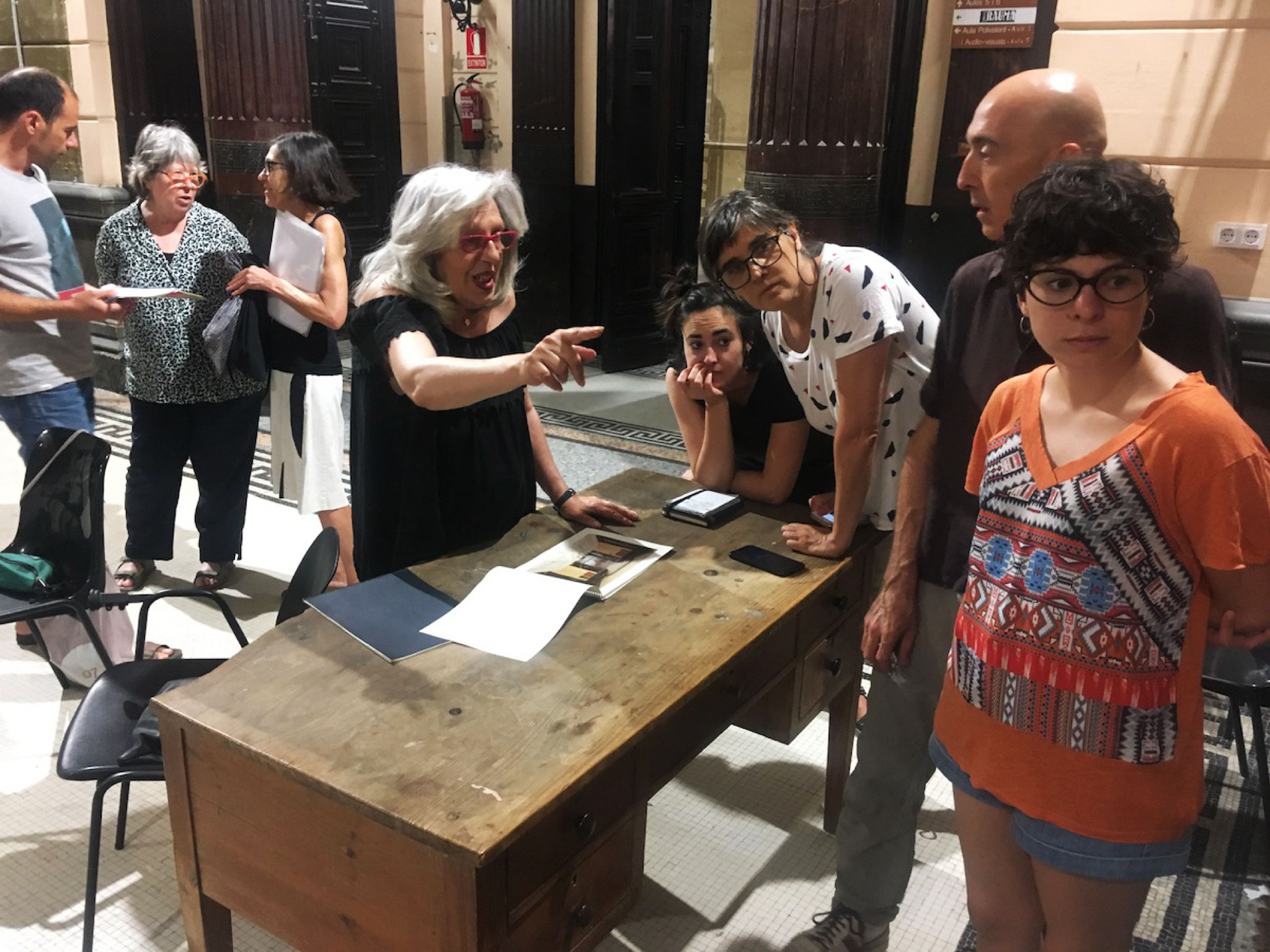Art project using research and cross-disciplinary work, applied to contexts in transition and defined by asymmetries, in which ways of living, locations or activities are the result of instability, transience or fragility, circumstances which at the same time demand projects which open up to change these situations.
Asymmetry is a concept that is linked to unequal, out of scale, unbalanced. In this case it is adopted to articulate a research project that analyzes the ways of life and the uses of those spaces in the city traversed by the concept of contemporary inequality. Asymmetry, understood as vulnerability, lack of equivalence between the parts, imposed precariousness, social dualization, uneven equalization; suggests that both the forms of life and the activities carried out in spaces enter into a process of instability, transience or fragility, where uses, relationships and spaces are simplified until they take a position in an asymmetric relationship. Another concept we used in before project was Zombie Spaces, (understood as not a dead space, but a space in which various ways of disjointed living have been reorganized). While it talks about spaces, not people, asymmetries talk about living conditions and habitability in spaces.
El Raval is one of the most complex neighborhoods in the old part of the city of Barcelona, which carries out historical problems wich affects the asymmetric relationships and precariousness that are currently manifested at different levels. In the years 2018-2019, a bitter controversy arise around a very specific case of inequality that pitted neighborhood associations against the City Council and sparked a wave of protests.
The subject of litigation was the building of the chapel of La Misericòrdia, because both Raval Nord Outclinic and Macba, Contemporary Museum of Barcelona, claimed it to expand their facilities. The confrontation was, then, between a health center and an art museum. Certainly, the cession of the space had been granted in 2013 to the Macba by the City Hall, but in 2018 it had not yet been enabled and the needs of the neighborhood were different. Actually, in 2018 the CAP facilities needed an expansion and renovation due to their precarious conditions and the impossibility of serving the entire population of the neighborhood. To which the platform + Macba + Cultura argued that they did not have to pay for the poor health management of the rulers.
It’s exciting to follow the controversy during the two years through the Barcelona press, because the transfer and re-qualification of urban spaces to solve the problem depended on three government institutions that did not agree. And they were changing plans according to pressure of the neighbors, according to the pressure of the museum consortium, according to the proximity of elections, etc.
The fact is that multiple protest activities were generated, especially from the Worthy Outclinic Raval Nord Platform, among them: occupation of the chapel by neighbors, artistic days and debates within the enclosure, demonstrations in front of the museum, etc.
One of these activities was the exhibition carried out by the resident artists and designers of the Asymmetries project, in which they presented artistic projects that emerged as a result of their research on confrontation, and which give rise to a deep reflection on the weaknesses of the care system in the contemporary cities. In this case, citizen pressure worked and finally the City Council gave up the chaplain to expand the CAP. Well, it worked, but in exchange for a strong investment by the government, because the government compensated the museum with the promise of construction of a new building for its planned expansion.
Asymmetry as a concept is simple, dual, and two-dimensional. In a context of complexity, it has the risk of decreasing the observation process and the action proposed. The idea of asymmetry could appear as insufficient to read, interpret or translate what happens in a specific place. It is in this sense that, as a research project applied to the urban context, it opens up to incorporate other concepts such as Foucault's "heterotopia". Term that refers us to places drawn by the network of relationships between people who are living in them, places which are irreducible to each other and impossible to superimpose. Worlds within other worlds. Heterotopies belong to a specific space, which have within themselves power, forces, ideas, regularities or discontinuities, that can be classified according to the time or place where they belong and open the possibility of creating new spaces with their own logics. As Foucauld said: -Museums libraries are typical heterotopies of our time.
Or the concept of "Third Space" by Edward Soja, understood as the place where everything comes together subjectivity and objectivity, the abstract and the concrete, the real and the imagined, the knowable and the unimaginable, the repetitive and the differential, structure and agency, mind and body, the conscious and the unconscious, the disciplined and the transdisciplinary, everyday life and endless history. Third space as another way of understanding and acting to change the spatiality of human life, a different mode of critical spatial awareness in which the social, the historical and the spatial are linked.
The general objective of ASYMMETRIES was to place creative practice within the framework of research and the redefinition of urban contexts, taken from a critical, counter-disciplinary perspective, and aimed at discovering, defining, or proposing concrete actions directed towards elements affected by contemporary asymmetries.
In all this process it is necessary to involve other people or groups whose daily life is affected by contemporary asymmetries. How ways of life interact with spaces, how spaces condition the way of inhabiting them.
The Asymmetries project was carried out for the first time in 2019, setting up a working group that held weekly meetings for nine months, and in each case an external collaborator was invited to discuss, from different disciplinary points, around the asymmetry concept. It concluded with a discussion session, with invited speakers and the presentation of the proposals put forward at the Fàbrica de Creació Fabra i Coats in Barcelona, and some artistic actions and interventions carried out in the occupied space Capella de la Misericodia in Barcelona.
ASYMMETRIES / ALPHABET A PROJECT ENGAGED IN SOCIAL CONTEXTS AFFECTED BY URBAN INEQUALITY
One of the projects taking part in ASYMMETRIES was ALPHABET ABECEDARIUM, as a resulf of collaboration between IDENSITAT, LA NEGRETA (Social Space of Gòtic) and the participation of the artist Angela Bonadies. It started as a workshop which launched several art projects shown as installations at the place of La Capella de la Misericòrdia in Barcelona.
Taking the concept of asymmetries, understood as situations of inequality or vulnerability, the idea with ALPHABET was to analyse how these take shape in some areas of the Ciutat Vella, as well as how certain collective options manage to mitigate them. The project started with a workshop which alternated urban tours with a viewing of examples, discussion sessions and the production of essays/visual materials related to the subject. The idea was to go into real contexts in depth, and to work critically or positively, always respecting those places in which certain fragilities acquire form.
In parallel, visual and audio-visual materials, texts and documents dealing with sensitive issues such as immigration, health, housing, exclusion or identity were discussed within the workshop setting. Similar cases, and how different contexts and supports are dealt with in these cases, was analysed. To have been focused and working individually or in groups, the realisation of an "illustrated alphabet" was proposed, based on the routes and the concerns raised.
Spaces and social organizations which participated as collaborators in the project:
Agora Juan Andrés Benítez. A space preserved in memory, self-managed, supportive mutuality where neighborhood program activities away from macho culture, violence and discrimination.
Plataforma el Borsí pel Barri / El Borsí platform through the neighborhood. Neighbors, collectives and social movements to claim a space for experimentation, creation and dissemination of the arts. (old school of arts)
Plataforma CAP Raval Nord Digne / CAP Raval North Worthy Platform. Fight to achieve what is fair and common sense thanks to the involvement of many people.
DIÀLEG DE DONES / Women's Dialogues. Create welcome and socialization spaces for women from non-EU countries, and build bridges for dialogue that facilitate social cohesion.
IMPULSEM / We promote. Develop integrative actions in the educational, social and labour spheres, to reduce the effects of social exclusion.
LA NEGRETA / The bold face of Gothic Neighbourhood. (social space rooted in the Gothic Quarter) Cooperate to promote political, social and cultural participation, from citizen self-management.
The project results were shown as intervention at Capella de la Misericòrdia, an occupied venue by neighbours involved in a controversial litigation with the Museum of Contemporary Art in Barcelona, called “Plataforma CAP Raval Nord Digne”. The neighbours had been fighting for the sanitary use of this building, against the Museum which claimed the building for their expansion.
The projects which participated in the performance were:
- Ángela Bonadies: Taller ABCEDARI, Ciutat Vella
- Teresa Picazo-Toni Sangrà: Vigila amb les pors. Online Dialogue
- Irma: Ejercicio de literatura potencial dentro de un polígono. Walking tour in Ciutat Vella.
- Martí Sala: Actuants
- Daniel Gasol: We are still here motherfuckers
- Fiona Capdevila: Veïna Viva
- Sonia G.Villar: Cardo en Flor
- Idensitat: ABCDIN
METHODOLOGY
The workshop combined dérives, walking tours around certain areas of the Ciutat Vella, and guided visits to these areas with agents from the local context. The purpose was to attempt an overview of existing asymmetries, and to gain the necessary information to advance an analytical look at the context. The workshop used images (photography, drawing, video) and text, with the aim of shaping the illustrated alphabet, covering a variety of topics and how they relate to the urban context. The second part culminated in a joint intervention which was presented in the place of CAP del Raval in Barcelona.
We are going to finish this presentation with some general, philosophical considerations. The great challenges that all human societies face in the present arise not from differences but from the asymmetries between the individuals that compose them and that cause great cracks and rifts in the social building. Differences connect with freedom and liberties, asymmetries with inequalities. It is not necessary to be a Hegelian or a Marxist to see that our societies are traversed by strong tensions, which are sometimes true contradictions, and which are more visible in large metropolitan areas. Barcelona is one of these cities in which the great asymmetries in relation to wealth, well-being and comfort of some citizens contrasts with the economic precarity, the precariousness of the accessing to housing, health, and education of important social groups in the same town. Precariousness and precarity are consequences of the inequality, which is the main political, social and cultural problem of the present. They are specific phenomena of capitalism which create an expanding condition in today's world. Despite the fact that since the 19th century and for more than a century different social movement have pushed back great inequalities, winning rights to decent wages, education and health, since the implementation of the neoliberal program initiated by Margaret Thatcher and Ronald Regan forty years ago, all these achievements have been progressively questioned and deconstructed, especially after the 2008 crisis. Probably the main problem for humanity today is the growing inequality that exists in all societies on the five continents. We qualify the growing inequality as the main problem because the other serious problems, these of global warming and the necessary ecological transition, cannot be seriously addressed at the planetary level without making great efforts to redistribute wealth. Perhaps there will be an ecological transition for the rich of the North, but not for the poor of the whole world. The pandemic situation that we have been experiencing for a year has only exacerbated these asymmetries and has brought the most flagrant and painful ones before our eyes. We know that precariousness and precarity are affecting many of our economic activities, cultural practices and ways of life. So, the poor have gotten sicker, they have had less access to hospitals, medical treatments and vaccines, they have had less access to education, work, and culture. Also, the digital divide has also been revealed as one of those invisible walls, but that divide societies as much or more than the visible walls. What can artistic research do in front of such realities of economic, social, psychological, cultural inequalities?
Artistic research projects cannot replace the institutions' public action plans to correct these serious asymmetries. Against what Dostoievsky's hero believed, art will not save the world, but it can make relevant contributions to the knowledge of these social realities not so much because it provides explanations of the facts, but because they provide an empathic understanding of them, formulated more in first and second person than in third. In short, of the three concepts proposed by this congress -dare, care, share–, artistic research can only address two of them.
Artistic research cannot take care directly, but it can contribute significantly to sharing the knowledge of what is happening. Our project ASYMMETRIES -ALPHABET was a mere example of what is possible for artistic research. But we would like to end this presentation with a desideratum connected to the first of verbs invoked in the title of this conference, the verb dare. Because artistic research is not only about finding answers or solving riddles about the present realities as we did with ASYMMETRIES project. Artistic research is also about continuing to pose the questions looking at the not yet real. Artists by their very nature move into new terrae incognitae – often embracing areas not yet defined by knowledge – areas that are still not yet knowable sensu stricto. So, artistic researchers should dare, even in conditions of cluelessness, to investigate alternative realities to put it ironically.
The radical potential of artwork always lies precisely in the destabilization of reality insisting on this essential incompleteness, a non-closure or non-totalizing of form. Artistic research can be a safe harbor for experimentation, risk and failure, moving into what can be identified as “a space for what cannot be named.” So, artistic research can dare to think differently, to imagine new concepts for alternative ways of life,what has been called a poetology of transformation to tell it from research in prospective. Modal research in the field of the possible is a challenge for contemporary artists working in practice-based research. For example, to dare to investigate and to share how to avoid that the future realities of the global warming and consequent mass migrations, of employement precarization trough digitalization and implementation of new technologies as Artificial Intelligence and Big Data, which are transforming markets and business, are all challenges that we should dare to investigate in parallel with scientists because it is the requirement of this time.
Asymmetries has been promoted by IDENSITAT -- a collective artistic research project -- in collaboration with Fabra i Coats Creation Factory and Contemporary Art Centre from Barcelona -- a municipal cultural venue -- and by MURAD, EEES master’s degree course in Research in Art and Design -- a collaboration between the Art and Design University EINA and the Autonomous University of Barcelona, UAB. / 2019

